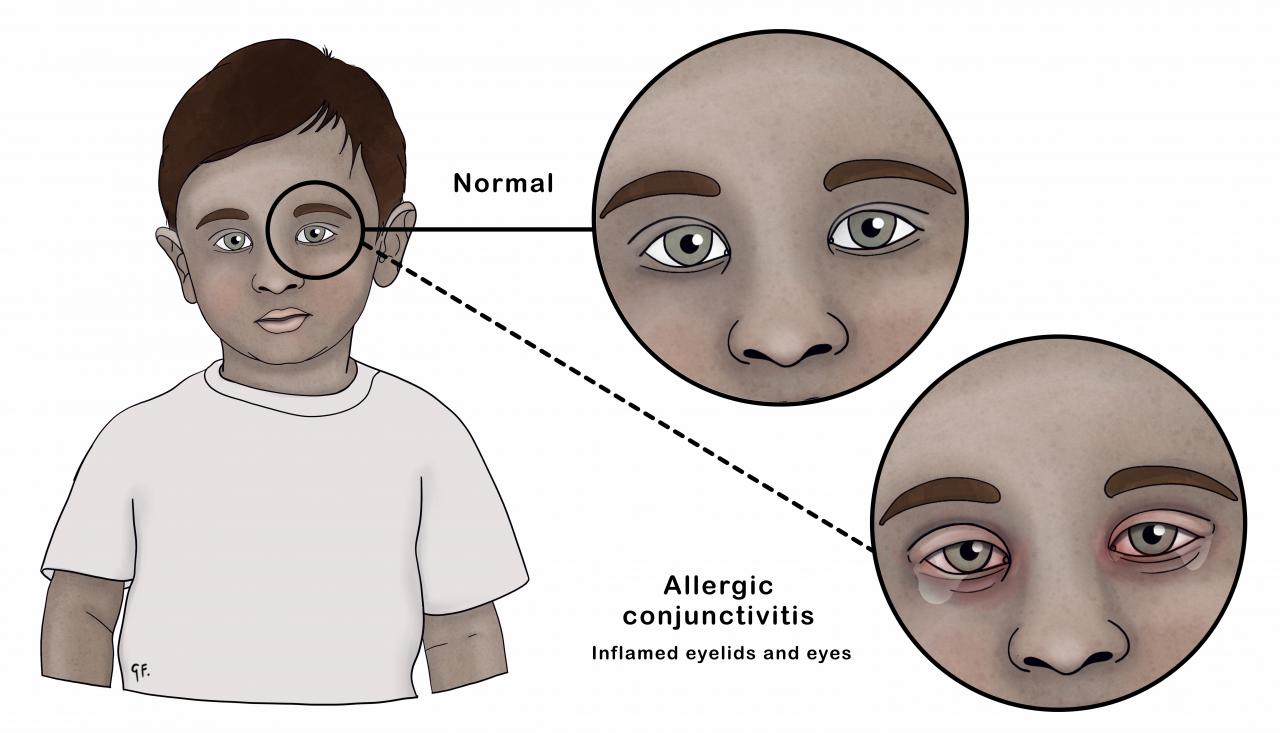Allergic Conjunctivitis In Children
Allergic Conjunctivitis In Children
Allergic conjunctivitis, also known as eye allergies, is a common condition affecting tamariki (children). It causes redness and irritation to the eyes and eyelids.
Key points about allergic conjunctivitis
- allergic conjunctivitis is common in tamariki
- symptoms include redness, itching and irritation to both eyes and eyelids
- pollen, grass and animal fur are common triggers
- antihistamine eye drops help relieve the symptoms of allergic conjunctivitis
What is allergic conjunctivitis?
Allergic conjunctivitis causes inflammation of the eyelids and eyes. It happens when the eyes react to allergens such as pollen, pet hair, or dust mites.
Conjunctivitis can be caused by allergies or infections. This page focuses on allergic causes of conjunctivitis.
See the KidsHealth page on conjunctivitis to learn more about other types of conjunctivitis.
Who gets allergic conjunctivitis?
Tamariki of all ages can get allergic conjunctivitis. It’s more common in tamariki who have other allergic conditions such as asthma and eczema. It’s also more common in tamariki who have family members with allergies.
What causes allergic conjunctivitis in children?
Allergic conjunctivitis occurs when allergens come into contact with the eyes, and they trigger a reaction.
Common allergens include:
- pollen
- grasses
- pet hair
- dust mites
- mould
When your child gets symptoms will depend on what triggers their allergic conjunctivitis. If they are allergic to a certain pollen, they may only get symptoms seasonally when lots of pollen is around. If they react to cat hair, they may only get symptoms when they are around cats.
What are the symptoms of allergic conjunctivitis?
Allergic conjunctivitis almost always affects both eyes. Symptoms in tamariki include:
- redness of the eyes
- red puffy eyelids
- itching
- watery teary eyes
- crusting around the eyes
- constant rubbing and scratching of the eyes
Should I take my child to see a health professional?
There are different types of conjunctivitis, so it is important to see a health professional if your child has symptoms of allergic conjunctivitis. A health professional can diagnose allergic conjunctivitis.
Take your child to a health professional immediately if they have:
- changes in their vision
- eye pain
- discharge from the eyes that is thick and discoloured
- are generally unwell with their conjunctivitis
These symptoms may suggest they have an eye infection.
See the KidsHealth page on conjunctivitis to learn more about other causes of conjunctivitis.
How is allergic conjunctivitis treated?
Treatment for allergic conjunctivitis aims to improve symptoms and lessen inflammation.
Antihistamine eye drops
You put antihistamine eye drops directly onto the eye. They help ease itching and redness.
Lubricating eye drops
Lubricating eye drops help soothe dryness and irritation. They also help flush out any allergens from the eyes. You can buy some lubricating eye drops at the pharmacy. Talk to your local pharmacist.
Antihistamines by mouth
Antihistamine medicine helps block the effects of allergens like pollen. Tamariki can take antihistamines as a tablet or a liquid. It is particularly helpful for tamariki who have other allergy symptoms, such as a runny nose or sneezing.
How can I manage my child’s symptoms at home?
Alongside medicine, there are some simple things you can do to help ease your child’s symptoms.
Avoid rubbing and itching
It is important to try and encourage your child to avoid rubbing and touching their eyes. Constant rubbing of the eyes can make your child’s symptoms worse and may affect their vision.
Stay away from triggers
If you know what triggers your child’s allergic conjunctivitis, try to stop them having contact with that allergen.
Cold compresses
A cold compress placed over the eyes can help relieve itch and inflammation. You can make a cool compress by rinsing a face cloth under cold water and gently squeezing out some of the water. Put it over your child's closed eye until they get relief (around 10 to 20 minutes).
This page last reviewed 05 June 2024.
Do you have any feedback for KidsHealth?
If you have any feedback about the KidsHealth website, or have a suggestion for new content, please get in touch with us.
Email us now
